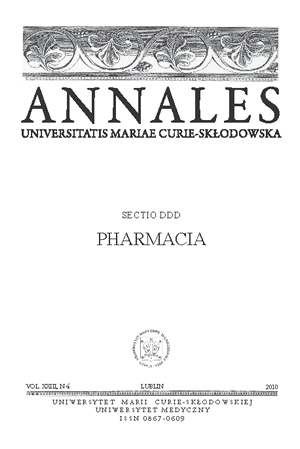Synthesis and biological activity of derivatives of 1-bromo-17-azapentacyclo[6.6.5.02,7.09,14.015,19]nonadeca-2,4,6,9,11,13-heksaen-16,18-dione.
Keywords:
N-substituted imides, 1-bromo-17-azapentacyclo[6.6.5.02,7.09,14.015,19]nonadec-2,4,6,9,11,13-heksaen-16,18-dione, antibacterial activityAbstract
We synthesized a series of eleven new derivatives of 1-bromo-17-azapentacyclo[6.6.5.02,7.09,14.015,19]nonadec-2,4,6,9,11,13-heksaen-16,18-dione and antibacterial activities in vitro was estimated towards Gram-positive, Gram-negative bacteria and yeast from the ATCC collection. We tried to perform modifications in order to maintain elements having influence on the biological activity. Despite it, in evaluated preliminary tests only two compounds (III–IV) showed activity towards Staphylococcus aureus and Candida albicans. Therefore, biological research will be executed for them in the nearest future. The main aim of the present investigation will be to assay the minimal inhibitory concentration (MIC), minimal bactericidal concentration (MBC) for these two tested compounds III and IV and tolerance of C. albicans standard and S. aureus strains, which occur as various phenotypes (MRSA, MSSA, VISA, hetero-VISA, VSSA).
References
1. Filho V.C., Pinheiro T., Nunes R.J., Yunes R. A.: Il Farmaco 1994, 49, 675-677
2. Zentz F., et al.: Il Farmaco 2002, 57, 421-426
3. Zentz F., et al.: Marine Biotechnology 2002, 4, 431-440
4. Jindal D.P., et al.: Il Farmaco 2005, 60, 283-290
5. Filho V.C., et al.: Il Farmaco 1998, 53, 55-57
6. Kossakowski J, Perliński M.: Acta Pol Pharm. 2001, 58(4), 257-62
7. Doshi RK, Patel G, Mackay R, Wallach F.:Mt Sinai J Med. 2009, 76(1), 84-94. Review.
8. Lass-Flörl C.: Mycoses. 2009, 52(3), 197-205. Review.
9. Clinical and Laboratory Standards Institute. Antimicrobial Susceptibility testing (M100-S16). Methods for dilution antimicrobial susceptibility tests for bacteria that grow aerobically: approved standard seventh edition (M7-A7). Performance standarts for antimicrobial disc susceptibility test approved standard-ninth edition (M2-A9). Clinical and Laboratory Standards Institute, Wayne, Pa, 2006.
Downloads
Published
Issue
Section
License
Copyright (c) 2010 Authors

This work is licensed under a Creative Commons Attribution-NonCommercial-NoDerivatives 3.0 Unported License.


